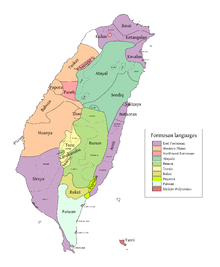Saisiyat language
| Saisiyat | |
|---|---|
| Native to | Taiwan |
| Ethnicity | spoken by 40–60% of Saisiyat (2002?) |
|
Native speakers
|
4,800 (2002) |
|
Austronesian
|
|
| Dialects |
|
| Language codes | |
| ISO 639-3 | |
| Glottolog | sais1237 |

|
|
Saisiyat is the language of the Saisiyat, a tribe of indigenous people on Taiwan (see Taiwanese aborigines). It is a Formosan language of the Austronesian family. It has approximately 4,750 speakers.
The language area of Saisiyat is small, situated in the northwest of the country between the Hakka Chinese and Atayal regions in the mountains (Wufeng-hsiang, Hsinchu, Nanchuang-hsiang, Miaoli).
There are two main dialects: Ta'ai (North Saisiyat) and Tungho (South Saisiyat). Ta'ai is spoken in Miao-Li and Tungho is spoken in Hsinchu.
Kulon, an extinct Formosan language, is closely related to Saisiyat but is considered by Taiwanese linguist Paul Jen-kuei Li to be a separate language.
Today, one thousand Saisiyat people do not use the Saisiyat language. Many young people use Hakka or Atayal instead, and few children speak Saisiyat. Hakka Chinese speakers, Atayal speakers and Saisiyat speakers live more or less together. Many Saisiyat are able to speak Saisiyat, Hakka, Atayal, Mandarin, and, sometimes, Min Nan as well. Although Saisiyat has a relatively large number of speakers, the language is endangered.
Orthographic notes:
Although it also allows for verb-initial constructions, Saisiyat is a strongly subject-initial language (i.e., SVO), and is shifting to an accusative language, while it still has many features of split ergativity (Hsieh & Huang 2006:91). Pazeh and Thao, also Northern Formosan languages, are the only other Formosan languages that allow for SVO constructions.
...
Wikipedia
